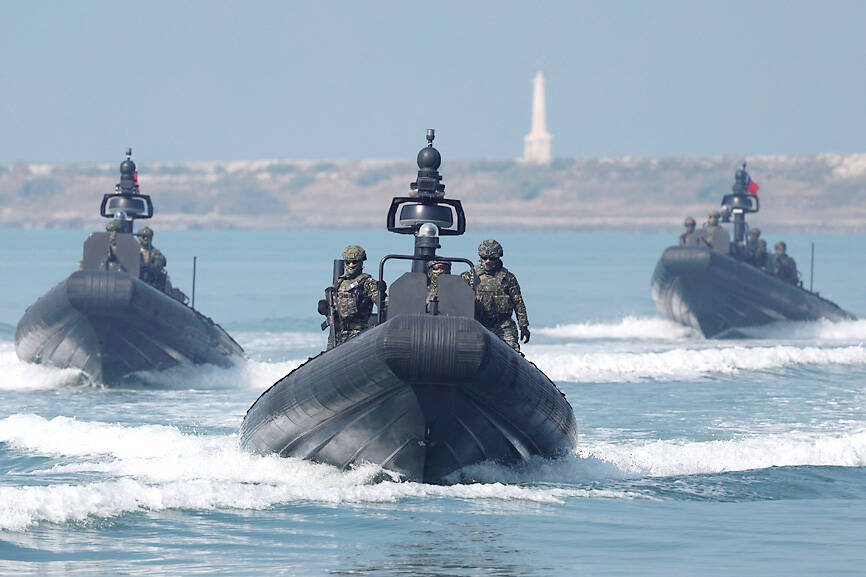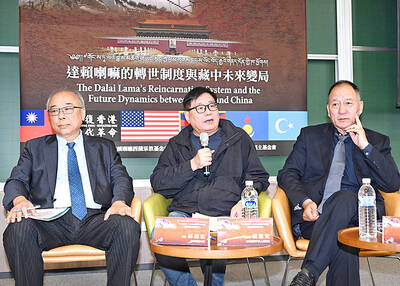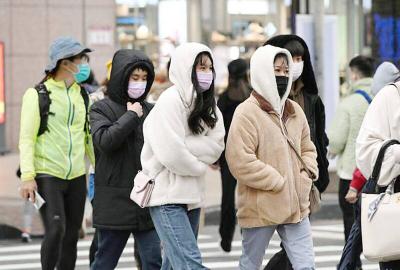Three of Taiwan’s field army commands this month would each hold anti-landing drills on a beach in their jurisdiction, including two public beaches, the Fisheries Agency said in three notifications on May 23 and Monday last week.
The first drill would be held on Wednesday by the army’s Tainan-based Eighth Army Corps on a public beach in the Sishu Coastal Recreation Area, the agency said.
The Sixth Army Corps on June 18 would be training on Jhongfu Beach (中福海灘) in New Taipei City, while the 10th Army Corps would conduct a live-fire drill on June 26 at Taichung’s Caocuosi Beach (草厝溪海灘), the agency said.

Photo: Carlos Garcia Rawlins, Reuters
The military has been strengthening its defense protocols with weapons practices, wargames and live-fire drills conducted on the nation’s “red beaches.”
Beaches in Taiwan are categorized into three color codes: Red beaches could see large-scale landing operations and are the most vulnerable to a Chinese People’s Liberation Army invasion; yellow zones are beaches that could see unconventional landing operations; and blue beaches are locations that would be difficult to invade.
Anti-landing drills that involve shooting practices on beaches aim to familiarize soldiers with the environment of a potential battlefield, the military said.
Firing rounds on beaches differs from target practice in controlled environments, as environmental factors such as wind and sand can affect visibility and the functionality of weapons, the military said.
The military also increased the number of anti-landing drills on red beaches, such as in Tainan’s Sishu Coastal Recreation Area.
Because these areas are accessible to the public, the army had only conducted basic drills such as physical training and hardware construction before the first live-fire exercise in Taoyuan’s Guanyin Coastal Recreation Area, which was held at the end of last year.
The three red beaches selected for the anti-landing drills this month were also evaluated by analyst Ian M. Easton in his book The Chinese Invasion Threat: Taiwan’s Defense and American Strategy in Asia for their tactical relevance.
Sishu (喜樹) could be a target due to its closeness to important locations such as Taoyuan International Airport and Tainan Air Base, and infrastructure such as the Coastal Highway, Easton said.
Jhongfu Beach was mentioned for its proximity to Taoyuan International Airport and Linkou Power Plant, as well as Caocuosi Beach, as it is near Taichung International Airport, which is also an air base.

ALIGNED THINKING: Taiwan and Japan have a mutual interest in trade, culture and engineering, and can work together for stability, Cho Jung-tai said Taiwan and Japan are two like-minded countries willing to work together to form a “safety barrier” in the Indo-Pacific region, Premier Cho Jung-tai (卓榮泰) yesterday said at the opening ceremony of the 35th Taiwan-Japan Modern Engineering and Technology Symposium in Taipei. Taiwan and Japan are close geographically and closer emotionally, he added. Citing the overflowing of a barrier lake in the Mataian River (馬太鞍溪) in September, Cho said the submersible water level sensors given by Japan during the disaster helped Taiwan monitor the lake’s water levels more accurately. Japan also provided a lot of vaccines early in the outbreak of the COVID-19 pandemic,

Kaohsiung Mayor Chen Chi-mai (陳其邁) on Monday announced light shows and themed traffic lights to welcome fans of South Korean pop group Twice to the port city. The group is to play Kaohsiung on Saturday as part of its “This Is For” world tour. It would be the group’s first performance in Taiwan since its debut 10 years ago. The all-female group consists of five South Koreans, three Japanese and Tainan’s Chou Tzu-yu (周子瑜), the first Taiwan-born and raised member of a South Korean girl group. To promote the group’s arrival, the city has been holding a series of events, including a pop-up

TEMPORAL/SPIRITUAL: Beijing’s claim that the next Buddhist leader must come from China is a heavy-handed political maneuver that will fall flat-faced, experts said China’s requirement that the Dalai Lama’s reincarnation to be born in China and approved by Beijing has drawn criticism, with experts at a forum in Taipei yesterday saying that if Beijing were to put forth its own Dalai Lama, the person would not be recognized by the Tibetan Buddhist community. The experts made a remarks at the two-day forum hosted by the Tibet Religious Foundation of His Holiness the Dalai Lama titled: “The Snow Land Forum: Finding Common Ground on Tibet.” China says it has the right to determine the Dalai Lama’s reincarnation, as it claims sovereignty over Tibet since ancient times,

Temperatures in some parts of Taiwan are expected to fall sharply to lows of 15°C later this week as seasonal northeasterly winds strengthen, the Central Weather Administration (CWA) said today. It is to be the strongest cold wave to affect northern Taiwan this autumn, while Chiayi County in the southwest and some parts of central Taiwan are likely to also see lower temperatures due to radiational cooling, which occurs under conditions of clear skies, light winds and dry weather, the CWA said. Across Taiwan, temperatures are to fall gradually this week, dropping to 15°C to 16°C in the early hours of Wednesday